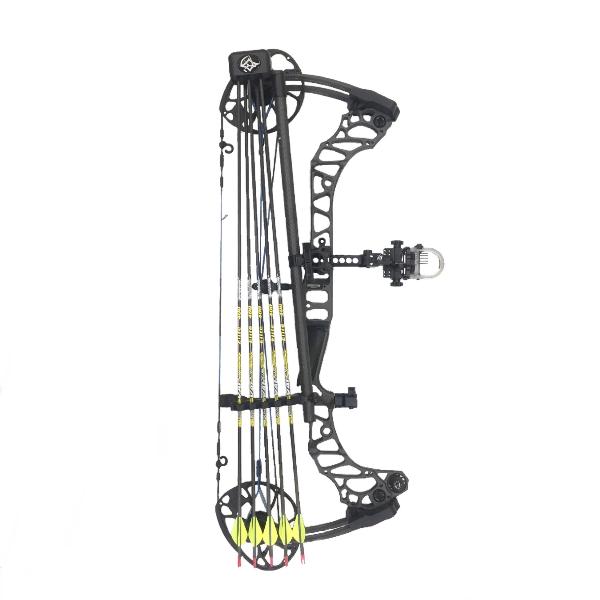Grasping Accuracy: The Duty of Compound Bow Stabilizers in Archery
Grasping Accuracy: The Duty of Compound Bow Stabilizers in Archery
Blog Article
Optimizing Your Archery Performance With the Right Compound Bow Stabilizer: a Detailed Summary
One often-overlooked yet crucial part in improving accuracy is the substance bow stabilizer. By comprehending the nuances of choose and enhancing a substance bow stabilizer, archers can fine-tune their equipment to boost their capturing experience to brand-new degrees of effectiveness and control.
Value of Bow Stabilizers in Archery

Furthermore, bow stabilizers assist in balancing the weight circulation of the bow, which can enhance the archer's stability while aiming and shooting. By including weight to the front of the bow, stabilizers can lower the quantity of torque experienced upon launch, resulting in a smoother and much more controlled shot - compound bow stabilizer. This weight distribution likewise assists in holding the bow constant for a longer period, allowing the archer to intend extra properly
Kinds of Compound Bow Stabilizers
When considering the numerous types of compound bow stabilizers available, it is vital to recognize their distinctive functions and features to identify one of the most appropriate alternative for maximizing archery efficiency. One of the most common sorts of substance bow stabilizers include sidebar stabilizers, front stabilizers, and back stabilizers. Sidebar stabilizers connect to the sides of the riser and assistance in balancing the bow throughout the intending process. Front stabilizers, likewise understood as long poles, are attached to the front of the riser and help in taking in and decreasing any vibrations caused by the release of the arrow, thus enhancing accuracy. Back stabilizers, also called back stabilizers, are placed to the rear of the bow and help in counterbalancing the weight of other accessories, leading to boosted security and consistent intending. Additionally, some stabilizers feature flexible weights that permit archers to adjust the equilibrium and feeling of their bows according to their choices, making them versatile choices for archery fanatics of all degrees.
Variables to Take Into Consideration When Choosing
In evaluating substance bow stabilizers, comprehending the unique features and features of each kind is vital for making an informed decision on the most suitable alternative to improve archery performance. When Your Domain Name picking a stabilizer, one should consider the weight of the stabilizer itself. By carefully evaluating these aspects, archers can select a substance bow stabilizer that straightens with their shooting style and maximizes their total efficiency on the archery array.
Installment and Modification Tips
For optimum performance and precision in archery, grasping the installation and adjustment of your bow stabilizer is vital. Proper installment begins with connecting the stabilizer to the bow's riser, ensuring it is firmly safeguarded.
When adjusting the stabilizer, go to this site begin with tiny incremental modifications rather than radical changes. Pay focus to exactly how the bow responds to adjustments in stabilizer settings and make changes accordingly. Regularly examine the stabilizer's rigidity and general condition to ensure it continues to operate ideally.
Maintenance and Care Standards

It is also important to store your bow with the stabilizer in a risk-free and safe and secure place when not being used. Prevent leaving it in severe temperature levels or revealed to guide sunshine for extensive periods, as this might cause damages to the stabilizer. Regularly examine the stabilizer's positioning to ensure it is still appropriately placed on your bow. Following these maintenance and care guidelines will help you obtain one of the most out of your bow stabilizer and enhance your general archery efficiency.
Conclusion
To conclude, selecting the right substance bow stabilizer is vital for maximizing archery performance. Understanding the significance, types, variables to consider, installment and adjustment pointers, as well as maintenance and treatment standards can greatly affect one's precision and consistency in shooting. By selecting a stabilizer that fits private needs and choices, archers can improve their total performance and achieve better outcomes on the variety or in competitors.
Bow stabilizers play an important function in improving an archer's accuracy and consistency by lowering resonances and supporting the bow during the launch of an arrowhead - compound bow stabilizer.In addition, bow stabilizers aid in balancing the learn this here now weight circulation of the bow, which can boost the archer's security while aiming and shooting. The most common types of substance bow stabilizers include sidebar stabilizers, front stabilizers, and back stabilizers. Back stabilizers, also called back stabilizers, are placed to the back of the bow and help in reversing the weight of other devices, resulting in improved security and constant intending. When selecting a stabilizer, one have to think about the weight of the stabilizer itself
Report this page